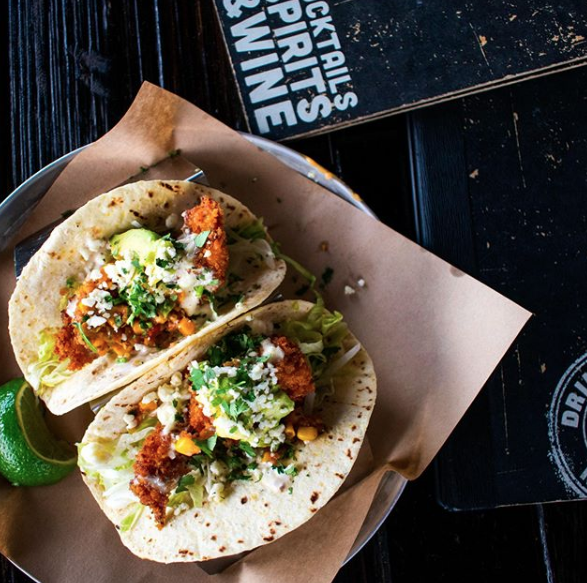Meat Men

My papa was a butcher—one of those gregarious, old school, Buddha-bellied guys. The larger than life, cleaver-wielding stereotype whose rosy cheeks matched his stained work apron. The type of person who knew the first name of everyone who walked through his door and how they liked their meat cut.
Back in those days, the relationship you had with your butcher was a lot like your relationship with your mechanic—in that it is built on trust and more than likely you talked about sports. Until recently, I had kind of assumed that the neighborhood butcher had gone the way of the milkman.
It wasn’t until I met Tony Tanner and Tim Struble, cofounders of Butcher & Grocer, a local meat market opening in Grandview this month, that I realized people still care about the customer-butcher relationship.
Tanner and Struble both fit the part when it comes to a couple of butchers. Tanner is a mammoth of a man with a hefty beard, bald head, and a smile as wide as his shoulders. Struble, who will also be acting as head butcher, is slightly smaller, with a neatly trimmed beard and an arm full of tattoos.
“My dad is a vegetarian,” Struble said. “He told me when I was really young that when I eat meat I should know where it comes from. I took that to heart.”
Struble started at Weiland’s Market when he was 16, and after 10 years of managing meat departments and various food co-ops, he graduated from OSU with a degree in English. After beginning his master’s program for teaching, he realized that his vocation was in meat.
“I was always called by one of my customers ‘the college-educated butcher.’ For me, it is great because I can talk about meat, write about it, and read about it. I never thought I would have a trade like this, but now I love it and I want to share my knowledge of meat with the world,” he said.
Tanner and Struble came up with the idea of Butcher & Grocer at a pig butchery class they attended. They both had the same concept about building a shop that exclusively sold products from local suppliers.
For Tanner, the importance of eating organic protein was the result of the death of his friend Rob Young, who died due to a rare form of lung cancer; an event that Tanner described as unusual for a healthy man in his age group.
“Before he passed, he had a feeling that food had something to do with his cancer. So, I started doing some research to learn about the food we eat. What I found is that there is a big difference between the stuff that is commoditized and the stuff that comes from farms,” he said.
Now that Tanner has two daughters, he makes damn certain his friend’s mistakes would not be repeated.
“I have to ask myself, what do I want them to eat? One of the things you do as a parent is you make sure that your kids are safe and healthy, so knowing where our food comes from is a big, big step in that.”
The problem that Tanner and Struble face is reconciling the demand for more popular cuts with their commitment of using every part of the animal.
“We have been working with our farmers to figure out how to do this. How do we meet the demand for filet mignon and rib eye without talking to Swift Premium or GFS? A big part is going to be educating the consumer, because in reality, there are only sixteen 8 oz. filets in an entire cow. So, what do you do? Well, the answer is you find a way to use everything else,” Struble said.
In order to sell the odd or less popular parts of the animal, the pair focuses on educating their customers about how to prepare their products, right down to including step-by-step preparation instructions on each package. And of course their staff, including general manager Dustin Butler, will also be well-versed in the ways of the meat.
“A lot of consumers know a filet, they know a rib eye, they know a porterhouse, but they don’t know what they can do with a chuck eye, or a chuck steak, or even something as simple as a London broil,” Butler said. “They might know what it is, but they don’t know how to utilize that cut. So, it scares them away. There might be a couple extra steps to cooking it, but it is going to be just as delicious, if not more. Our goal is to teach the public about what we have and how they can use it to feed their family.”
It is this fear, or at times inconvenience, that has fashioned a new culture of meat apathy. In order to rectify this, Butcher & Grocer is also focusing on knowing their farmers.
“The farmers that we are using, the ones we built relationships with over the past year and who are committed to what we are doing, do everything they can to find the right things to feed their animals. Our beef is non-GMO fed, our pork is mostly foraging for its food, and their animals are hormone and antibiotic free. Our farmers even run their farms using solar panels. That is the piece to the puzzle that we seem to miss when we start talking about how we want our food to come to us,” Tanner said.
Anymore, buzzwords like “local” and “organic” are nothing more than marketeering ploys to sell products. Make the package green, throw on some fancy font, and bang, you have organic. What Tanner and Struble are doing is completely different.
“We can just say that it looks good, and it says local, but what I tell everybody is that it is not good enough just to say local anymore. The consumer demands it, and as a father, I demand it. If you go to a place and ask where they get their meat from, the manager shouldn’t be confused about that question. That is not what we are going to be about. Every employee in our butcher shop, all the people we work with will know about our farmers, how they raise their animals, and how important that is. Our customers are the type of people that will demand that type of information.”
Butcher & Grocer will be opening its doors this month, distributing protein from the likes of Fox Hollow Farm and Woodland Ridge Farm & Learning Center. In addition, Chef Dan Varga of the Explorer’s Club and Double Happiness has teamed up with James Anderson of Ray Ray’s Hog Pit to create the Hungarian Butcher, an autonomous charcuterie shop running out of the store.
Tanner and Struble’s venture has also partnered with Dan the Baker, North Market Spices (and others to be announced) to fill the walls of its grocery section, fulfilling the duo’s commitment to local products. In addition, they said they would be accepting EBT food stamps, agreeing that everyone has the right to access ethically raised meat.
“The farmers are the artists, the animals are their art, and we are the gallery,” said Struble.
My papa would be proud.
Butcher & Grocer is located at 1089 W First Ave.
For more, visit thebutcherandgrocer.com.
BROUGHT TO YOU BY



